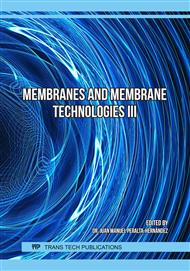[1]
D.D. Fazullin, G.V. Mavrin, I.G. Shaikhiev, E.A. Haritonova, Separation of oil products from aqueous emulsion sewage using a modified nylon–polyaniline membrane, Petroleum Chemistry. 56 (2016) 454-458.
DOI: 10.1134/s0965544116050054
Google Scholar
[2]
M. Morshed, A. Zimmer, L. Broch, H. Alem, D. Roizard, PDMS membranes modified by polyelectrolyte multilayer deposition to improve OSN separation of diluted solutes in toluene, Separation and Purification Technology. 237 (2020) 116331.
DOI: 10.1016/j.seppur.2019.116331
Google Scholar
[3]
A.D. Badaraev, A. Koniaeva, S.A. Krikova, Piezoelectric polymer membranes with thin antibacterial coating for the regeneration of oral mucosa, Applied Surface Science. 504 (2020) 144068.
DOI: 10.1016/j.apsusc.2019.144068
Google Scholar
[4]
W. Qing, X. Shi, W. Zhang, Solvent-thermal induced roughening: A novel and versatile method to prepare superhydrophobic membranes, Journal of Membrane Science. 564 (2018) 456-472.
DOI: 10.1016/j.memsci.2018.07.035
Google Scholar
[5]
S. Neumann, G. Bengtson, D. Meis, V. Filiz, Thermal Cross Linking of Novel Azide Modified Polymers of Intrinsic Microporosity-Effect of Distribution and the Gas Separation Performance. Polymers. 11 (2019) 1241.
DOI: 10.3390/polym11081241
Google Scholar
[6]
D.D. Fazullin, R.D. Fazylova, Purification of water from heavy metal ions by a dynamic membrane with a surface layer of cellulose acetate, IOP Conf. Ser.: Earth Environ. Sci. 421 (2020) 062032.
DOI: 10.1088/1755-1315/421/6/062032
Google Scholar
[7]
L. Yan, et al., Effect of nano-sized Al2O3-particle addition on PVDF ultrafiltration membrane performance, Journal of Membrane Science. 276 (2006) 162-167.
DOI: 10.1016/j.memsci.2005.09.044
Google Scholar
[8]
P.H.H. Duong, V.A. Kuehl, B. Mastorovich, J.O. Hoberg, B.A. Parkinson, K.D. Li-Oakey, Carboxyl-functionalized covalent organic framework as a two-dimensional nanofiller for mixed-matrix ultrafiltration membranes. Journal of Membrane Science. 574 (2019) 338-348.
DOI: 10.1016/j.memsci.2018.12.042
Google Scholar
[9]
D.D. Fazullin, G.V. Mavrin, I. G. Shaikhiev, Modified PTFE–PANI membranes for the recovery of oil products from aqueous oil emulsions, Pet. Chem. 57 (2017) 165.
DOI: 10.1134/s0965544116110062
Google Scholar
[10]
M.L. Lind, et al., Effect of mobile cation on zeolite-polyamide thin film nanocomposite membranes, J. Mater. Res. 24 (2009) 1624-1630.
DOI: 10.1557/jmr.2009.0189
Google Scholar
[11]
E. Jashni, S.M. Hosseini, Promoting the electrochemical and separation properties of heterogeneous cation exchange membrane by embedding 8-hydroxyquinoline ligand: Chromium ions removal, Separation and Purification Technology. 234 (2020) 116118.
DOI: 10.1016/j.seppur.2019.116118
Google Scholar
[12]
M. Andreeva, N. Loza, N. Kutenko, N. Kononenko, Polymerization of aniline in perfluorinated membranes under conditions of electrodiffusion of monomer and oxidizer, Journal of Solid State Electrochemistry. 24 (2020) 101-110.
DOI: 10.1007/s10008-019-04463-7
Google Scholar
[13]
Y. Liu, Q. Han, T.T. Li, J. Hua et al., Heparin reduced dialysis through a facile anti-coagulant coating on flat and hollow fiber membranes, Journal of Membrane Science. 595 (2020) 117593.
DOI: 10.1016/j.memsci.2019.117593
Google Scholar
[14]
D.D. Fazullin, R.D. Fazylova, L.I. Fazullina, G.V. Mavrin, Obtaining and properties of a composite membrane with a surface layer of cellulose acetate, Journal of Physics: Conference Series. 1347 (2019) 012035.
DOI: 10.1088/1742-6596/1347/1/012035
Google Scholar
[15]
M. Khayet, C. Garcia-Payo, T. Matsuura, Superhydrophobic nanofibers electrospun by surface segregating fluorinated amphiphilic additive for membrane distillation, Journal of Membrane Science. 588 (2019) 117215.
DOI: 10.1016/j.memsci.2019.117215
Google Scholar
[16]
D.D. Fazullin, G.V. Mavrin, Separation of water-oil emulsions using composite membranes with a cellulose acetate surface layer, Chemical and Petroleum Engineering. 55 (2019) 649-656.
DOI: 10.1007/s10556-019-00674-x
Google Scholar




